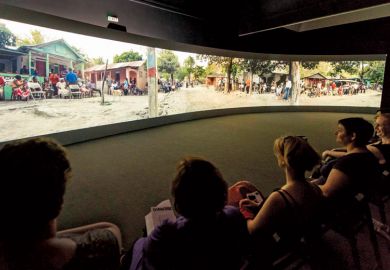A man with a guitar takes to the stage, and proceeds to deliver a 20-minute seemingly atonal performance – punctuated by reverberating pedal effects – of Ghost Trance Music, inspired by Native American dance rituals.
It certainly isn’t mainstream music. But should it count as academic research?
This question is at the heart of a battle for recognition being fought by Europe’s artistic researchers, who say their work still isn’t taken seriously as proper scholarship by some academics, governments and official bodies.
“It’s about recognition,” said Andrea Braidt, president of the European League of Institutes of the Arts (Elia).
Last year, an alliance of arts education institutions signed the Vienna Declaration on Artistic Research, a call for this “relatively young field” to be funded “in line” with the humanities and sciences.
Despite a rapid take-off in publications over the past two decades, artistic research still “does not have equal access to research funding as other fields of research or is not at all eligible to apply for research grants or scholarships”, the declaration says.
Simply put, artistic research uses performance to explore research questions. This might be as prosaic as trying out a new type of mouthpiece for a trombone, for example, or it could be an attempt to delve into entirely new forms of “artistic expression”, explained Stefan Gies, chief executive of the European Association of Conservatoires.
An artistic research performance, be it of music, dance or painting, is the “output” of longer, broader enquiry into a question, explained Professor Braidt, involving “academic reflection and documentation about how the artistic work came into being”.
A work of art with no more explanation than “oil on canvas” does not count, she said, as it might be moving, but it “doesn’t tell you the detailed methodology about how it comes into being”.
Art that emerges from artistic research needs to “stand on its own”, she said, but it also “needs to be transparent about what kind of research question it’s looking into”.
Above all, explained Mr Gies, the artistic process has to be described in such a way that the whole project is “useful for someone else”, something that is “true of all research”.
This is far from easy, he stressed. At least half of artistic projects were “not well done” and in a collection of, say, 10 performances, there might be “eight projects that are fully bullshit”, he said.
But the problem is that some sceptical art academics perceive all such performance-linked research as “bullshit”, he said. In France, Germany and Italy, where sceptics often sit on funding panels, this has meant the field has been deprived of grants, he complained.
“For a long time, we didn’t get a single cent for artistic research in Germany,” he said.
On the contrary, funding programmes in Austria, the Netherlands and Switzerland are well developed, said Professor Braidt.
Now, the field wants the ultimate mark of recognition: inclusion in an obscure statistical manual that is nonetheless the “backbone” of research policymaking in many countries.
The Frascati Manual, updated by the Paris-based Organisation for Economic Cooperation and Development (OECD) roughly once a decade since the early 1960s, classifies what counts as research and development, exerting a powerful behind-the-scenes influence over which types of research are taken seriously and get funded.
“If the statistics cannot account for artistic research as a discipline, we can never know how much money goes into artistic research,” said Professor Braidt. “It’s really critical to have that included.”
“Its influence goes beyond the primary intended use,” said Fernando Galindo-Rueda, a senior economist at the OECD and one of those responsible for the manual. “What gets measured gets counted, and what gets counted ends up shaping decisions.”
If a country wants to encourage research and development, governments end up “implicitly or explicitly” referring to the Frascati Manual to see what kind of spending counts towards this goal, he explained. It can also determine which kinds of organisations get tax relief, he added.
Artistic research is not the only borderline field in the manual, he said: mineral exploration and software development are also edge cases.
The current manual does not explicitly exclude “artistic research” from tallies of research and development. Instead, it sets out a series of criteria, stressed Dr Galindo-Rueda, as the OECD “can’t get into every particular case”.
Still, the manual states that “artistic performance is normally excluded from R&D”.
This is because performance fails the “novelty test” because it is “looking for a new expression rather than for new knowledge”, and is not reproducible.
“As a consequence, arts colleges and university arts departments cannot be assumed to perform R&D without additional supporting evidence,” it says.
“Research differs between theoretical mathematics, and law, and philosophy; there are huge differences in what is the outcome, and huge differences in the expectation of methodology,” countered Professor Braidt. “Artistic research only differs in [that] the tools that you approach the question [with] are artistic ones.”
Discussions between the OECD and arts organisations about updating the manual are ongoing – but with the next edition expected in 2025, artistic researchers still have a long time to wait for full recognition.
POSTSCRIPT:
Print headline: Is artistic research the real deal?
Register to continue
Why register?
- Registration is free and only takes a moment
- Once registered, you can read 3 articles a month
- Sign up for our newsletter
Subscribe
Or subscribe for unlimited access to:
- Unlimited access to news, views, insights & reviews
- Digital editions
- Digital access to THE’s university and college rankings analysis
Already registered or a current subscriber?








